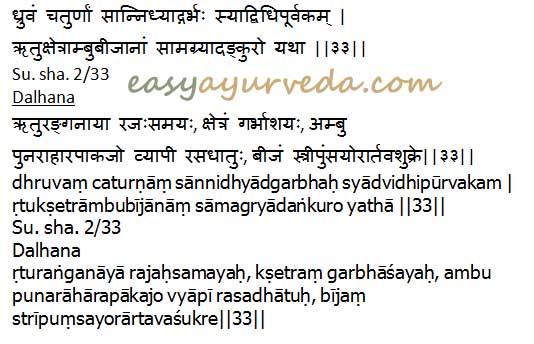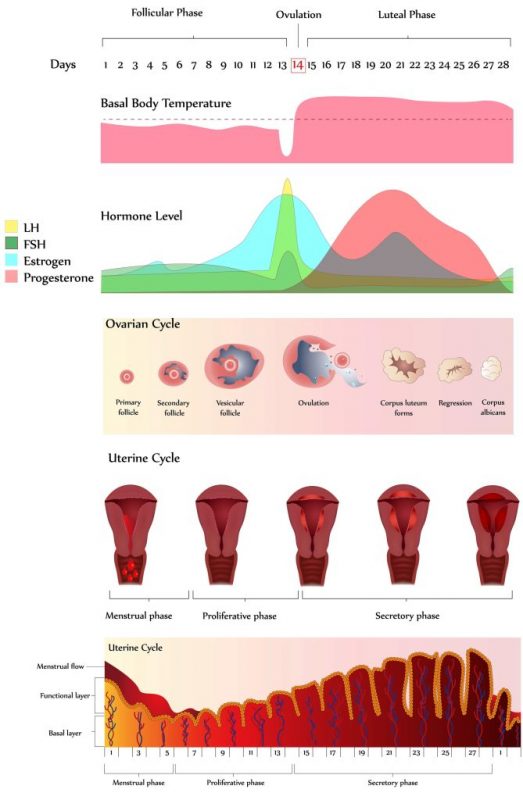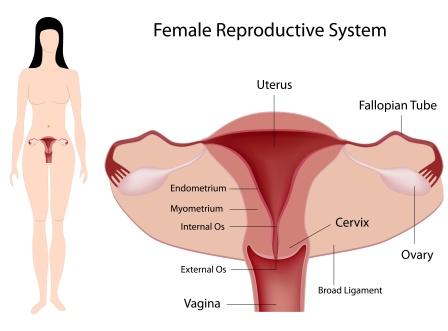Essential Elements For Conception – Garbha Sambhava Samagri
Article by Dr Raghuram Y.S. MD (Ay) and Dr Manasa, BAMS
For each and every product to be formed, we need essential ingredients which make that product. For a pot to be made, mud, wheel, water, fire, stick and potter are needed. For making a cloth, threads, weaving machine, dyes and weaver are needed. Similarly there are some essential and mandatory elements or ingredients needed to form a human body also. These ingredients are called garbha sambhava samagri.
(Garbha=fetus, embryo, Sambhava=forming, Samagri=ingredients).
Table of Contents
Garbha Sambhava Samagri
Garbha Sambhava / Utpatti Samagri (elements needed for formation of Garbha or foetus)
There are 4 essential factors or ingredients needed to form the Garbha. They are –
Rutu – Ideal season, in terms of fertile period in woman (ideal for conception)
Kshetra – Fertile land, in terms of Disease free and healthy womb (uterus)
Ambu – Proper water supply, in terms of nutritional supply to the foetus (foetal circulation)
Beeja – Healthy seed, in terms of Sperm of man

The essential ingredients needed for the formation of Garbha has been explained with an example of a plant (sapling).
For the plant to come into existence 4 factors are essentially necessary.
They are –
Rutu – Proper and compatible climate
Kshetra – Fertile land
Ambu – Water and nutrients
Beeja – Good quality seed
Similarly 4 factors or ingredients are needed to form Garbha. They are explained in same terms i.e. Rutu, Kshetra, Ambu and Beeja.
In the next few paragraphs, I would make an attempt to explain the ingredients needed to form garbha i.e. Garbha sambhava samagri in comparison with the ingredients or factors needed to form a plant.
Rutu
1. Rutu
Rutu means an ideal climate for seeding and for the plant to grow. The seeding and cultivation of a plant should be done in an appropriate climate or season, compatible enough for the plant to grow. If the climate or season is not favorable for the plant to grow, one cannot expect the seed to break open into a beautiful plant.
The same rule is applicable to the Garbha also. For the Garbha to be formed, an ideal climate should prevail in the garbhashaya (uterus and fallopian tubes) for the sperm to fertilize the ovum. This coincides with the fertile period of the female.

Rutu (ideal time and period for conception) in terms of garbha utpatti samagri –
The menstrual cycle of a woman comprises of fertile phase and non-fertile phase. The conception doesn’t take place on all days. Timing is important. The sperms should enter the uterus a couple of days before ovulation (release of egg or ovum from the ovary in woman). The sexual intercourse should be planned accordingly. 4th to 15th day of menstruation (after the periods have stopped, stoppage of bleeding) is the ideal kala for conception.
According to modern science, the day of ovulation in women is 14th day and conception period is 12th to 16th day. This is called fertile period. When the husband and wife have intercourse on these days, there will be strong chances that the woman conceives. The sperms, in the availability of suitable environment within the uterus (as created by hormonal changes before ovulation), can stay active for couple of days, whereas the ovum has a lifespan of 24 hours after ovulation. If it is not fertilized by a sperm within this time, the ovum gets destroyed. So it is important that the sperms are available in the uterus to fertilize the egg at the time of ovulation. This shows the timing of sexual act and the need of plan to beget a child. Knowing the menstrual cycle, its length and time of ovulation is essential for both man and woman planning to have a child.
Apart from this, the kala or ideal period also includes the physical and mental preparedness of the woman to receive the spermatozoa, to conceive.
Thus Rutu covers – an ideal environment provided by the uterus so as to welcome the sperms and have them in active state until ovulation, the days around ovulation, the timing of planning coitus and the preparedness of the woman to receive the sperm.

Kshetra
2. Kshetra
Kshetra means fertile land, ideal for the plant to grow. Though the seed is essential for the plant to grow, we cannot expect the seed to take the form of a plant anywhere and everywhere. An ideal and fertile land is needed for this process to happen. Only if the seed is sown in a fertile land which is healthy, the seed breaks up into a beautiful plant or sapling.
The same rule is applicable for the formation of Garbha also. Here the land correlates to a disease free and healthy uterus, the womb of the woman or Garbhashaya.
Kshetra (ideal land) in terms of garbha utpatti samagri –
Kshetra in terms of Garbha formation should be taken as the place where the fertilized ovum gets adhered and grows. This happens in the womb or uterus of the woman.
After the semen has been ejaculated into the vagina of the woman (following sexual intercourse), the containing sperms swim into the uterus (organ which holds the growing fetus until it is delivered at full term) and move towards the fallopian tubes or ovarian tubes (tubes carrying the ovum or egg from the ovary towards the uterine cavity, after ovulation). The ovum which is coming towards the uterus following ovulation meets the sperm. The sperm enters the ovum and fertilizes it. The fertilized ovum now comes into the uterine cavity and gets adhered into the wall of the uterus. This process is called implantation.
After implantation, the uterus becomes home for the embryo and growing fetus until it gets matured enough to reach the term, i.e. the period of delivery (being born). This according to Ayurveda is the kshetra for garbha. The future of the child after its birth depends on how well it was brought up and nourished in the mother’s womb. Therefore, from the Garbha perspective, Kshetra becomes very important. It is the first home for all living beings.
For healthy implantation and growth of the garbha, the kshetra or uterus should be in a healthy condition. It should be devoid of any disease or infection. An unhealthy womb will not allow proper implantation and growth of the child. The point of caution is to find out any disease related to uterus and treat it before conception.
Ambu
3. Ambu
Ambu means water. For a plant to sprout from its seed and for the seed to shape into a plant, the most essential element or ingredient needed is water. If the water supply to a plant is cut off or if water is not provided to the fields in which seeds are sown, one cannot expect to see the uprising of plants. In fact the seeds shrink and die out in the soil. The other nutrients which support the growth of plant or expression of a seed in the form of plant are also included under this topic.
The same rule is applicable for the garbha also. For the garbha (shukra-shonita or fertilized ovum) to grow properly nutrition is needed. This nutrition is compared to the ambu or water (in terms of its correlation to the plant).
Ambu (water and other essential nutrients, nutrition to the growing fetus) in terms of garbha utpatti samagri –
Nourishment to the fetus is offered through the ahara rasa (essence of nutrition) of mother through the fetal circulation. This nutrition is essential for the fetus to develop and grow in the womb properly and proportionally. The mother and growing child is single unit. This also contributes to the Rasaja bhavas (or qualities due to the nutritive essence obtained from mother in intra-uterine life) in the child (could be seen after child birth), which is unique for each child.
If this nutrition to the embryo is cut off, the fetus doesn’t grow properly or one can find stunted growth or mal-formations.
Fetal Circulation –
Circulation takes place in all of us. But when the child is in the mother’s womb, a special type of circulation takes place, which enables the growth and development of fetus in proper way. This is called fetal circulation.
Since the fetus cannot take its food independently, it has to depend on the mother’s food for nourishment. So the nutrients, and oxygen should reach the fetus from the mother’s blood and the carbon dioxide and metabolites must be taken away by the mother’s blood. To carry out these 2 functions, the circulation must be established between the mother and fetus. This motive is achieved by fetal circulation.
The exchange centre for these 2 bloods of mother and fetus is the Jarayu (placenta). The circulation takes place through the blood vessels of the mother draining and receiving through the umbilical cord of the fetus (nabhi), via the umbilical cord. After birth, the umbilicus of the fetus remains as a scar (forms the navel), and the cord is cut off.
The whole process is covered under the term ambu. The smooth run of this mechanism throughout the intra-uterine life of the child is mandatory for a healthy child to be born.
Beeja
4. Beeja
Beeja means seed (seeds). Most plants grow from their seeds. It is essential that a healthy seed be sown in a fertile soil (land) and be nourished with good water supply, essential nutrients and supportive climate to beget a healthy plant from a seed.
The same rule is applicable for the garbha. For a healthy garbha to be formed, its seed i.e. sperm from which it is derived should be healthy in terms of quality and quantity, enriched with good qualities. A diseased, contaminated or mutilated sperm cannot produce a healthy offspring. Beeja covers the male gamete i.e. sperm (sperms) and semen which carries the sperms.
Beeja (healthy seed, in terms of healthy semen and sperms of man) in terms of garbha utpatti samagri –
Semen or sperm is the most important component helpful in the formation of Garbha. It is the contribution of man towards formation of garbha. Shukra is the 7th dhatu (tissue) formed in the sequence of formation of tissues (according to Ayurvedic chronology of tissue formation). It carries vital components and memories of the previous 6 dhatus i.e. Rasa (digestive essence, lymph, and plasma), Rakta (blood), Mamsa (muscle), Meda (fat), Asthi (bones) and Majja (bone marrow). Thus it helps in the formation of the same tissues in the body which it creates after its union with artava. Of course, the Artava too contributes towards the formation of body and body parts.
Thus, Beeja (the seed, sperm of man), healthy and disease free sperm and semen in adequate quantity and exemplary quality is necessary to seed the ovum and beget a healthy fetus.
Just before finish –
Living in a modern era, fertility has become a key issue. Fertility rates have been decreasing with passage of every decade. Infertility has become a challenge to the medical science. But it seems that Ayurvedic medical science has clearly documented the key ingredients of conception and begetting a healthy child in a 2 lined verse. This not only allows us to know the ingredients needed to form garbha but also helps us to understand the areas which should be focused upon when infertility or fertility related issue is being discussed. The health of woman in terms of her menstrual regularity and maintenance of uterine and hormonal health, the health of men in terms of having good quality sperms and good quantity semen, the time of conception and nutrition to the fetus have all explained in relation to each other. They should be regarded as 4 limbs of formation of garbha. If any limb has a lacuna, the child born will not be at the best of health. Thus the physical preparedness of man and woman along with timing of sex and nutrition of pregnant woman has been stressed in this part of Ayurvedic embryology.
Click to Consult Dr Raghuram Y.S. MD (Ayu)










5 comments
Raje
Dear Doctor
Very helpful information, excellent comparison with examples in nature.
Information given in last para is very true….and worrying condition for Indian society.
Aj
Dear Doctor,
Does fibroid’s harm pregnancy, as there is no problem other than one fibroid.
Thanks,
Dr J V Hebbar MD(Ayu)Author
If it is only one and is small size, then usually it does not harm pregnancy.
Srinath
Very nice explanation, Thank you Doctor
R.Ramanathan
Very good explanation. My sincere thanks to Doctor